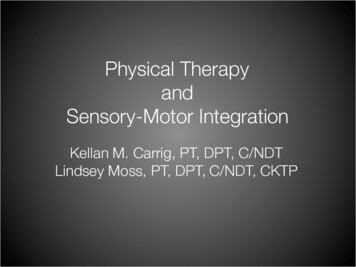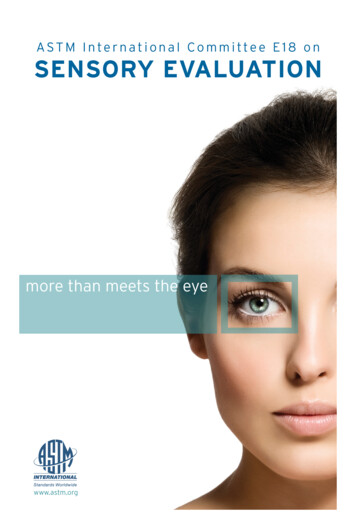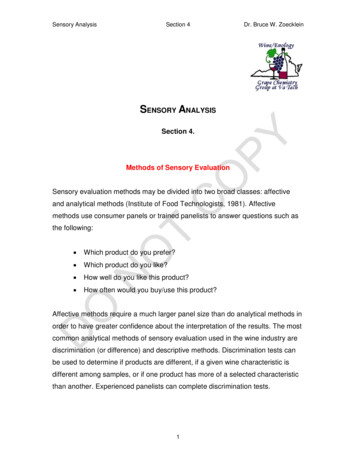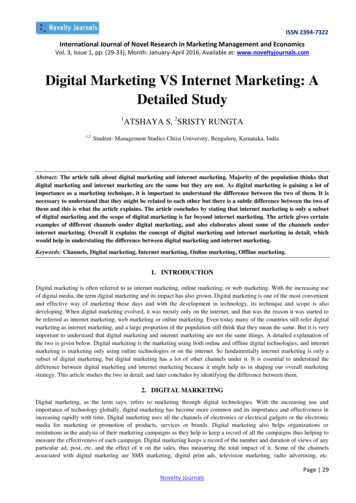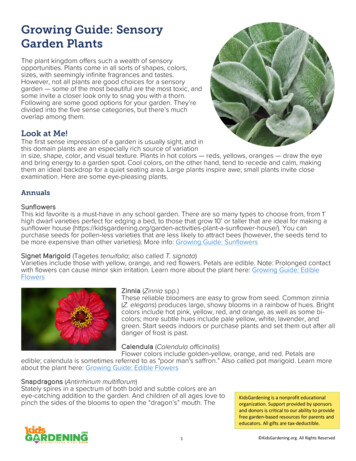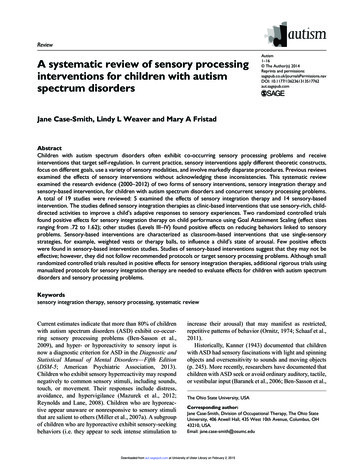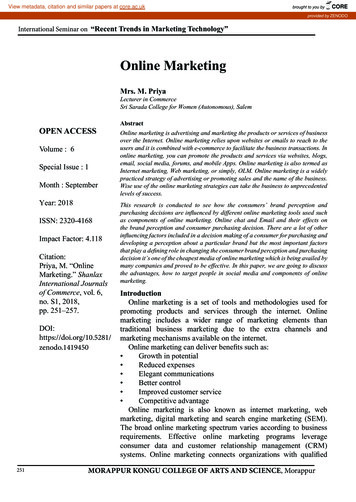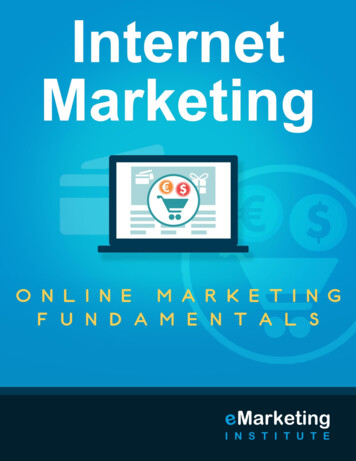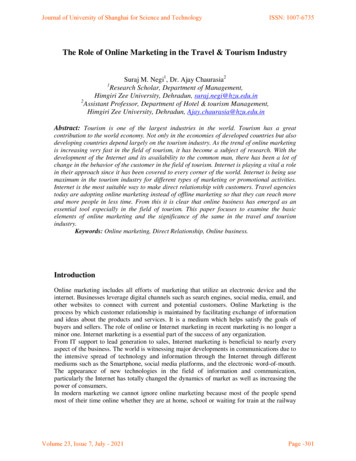
Transcription
Online Sensory Marketing: Developing Five-Dimensional Multi-Sensory BrandExperiences and its EffectivenessShreya Kaushik1; Nilesh Gokhale2*1Symbiosis Institute of Media and Communication, Symbiosis International (Deemed University), Pune,Maharashtra, India.2*Symbiosis Institute of Media and Communication, Symbiosis International (Deemed University), Pune,Maharashtra, India.2*nilesh.gokhale@simc.eduAbstractThe online environment has long been a sensory interaction between a brand or product and itsconsumers through visual imagery and sonic elements. While newer technologies have developed thatcater to a customer's more psychological need for haptics (touch), gestation, and olfaction, brandshave not explored its true potential. Immersions and other forms of Human-Computer interactionhave vastly developed and present scope for more than just a single sense for online consumers.While brands are employing these multisensory interfaces (vs. single-sensory) in certain productcategories, it remains to be seen whether customers who unknowingly experience sensations onlinewant to adapt to it. Several product categories could find multisensory elements beneficial. This studyaims to delve deeper and understand the motivations of such behavior and identify the need for acustomer to engage all its senses beyond the traditional visuals and sound while interacting withbrands virtually for a more holistic experience. While external environmental factors such aspandemics have resulted in the inevitable loss of physical touchpoints, the aim is to determinewhether sensory elements beyond images and sounds will benefit customer engagement.Key-words: Gestation,Environmental ntsBeneficial,1. IntroductionThe digital boom has largely benefited brands with their customers largely depending ononline interfaces to make purchasing decisions. While browsing brands online, we often wonder whata particular piece of clothing would look like on us or the smell of a particular fragrance [1]. WhetherISSN: 2237-0722Vol. 11 No. 4 (2021)Received: 28.07.2021 – Accepted: 30.08.20215375
those delicious dishes on our Instagram feed is just as tasty as it is in our minds. Whether or not beingin Paris would be as delightful and serene as it is for the couple featured in an AirBnB Ad.Customers desire to have memorable experiences which stimulate them both physically andmentally. This paradigm shift from production to a marketing concept gave way to developing the'marketing of senses,' otherwise known as Sensory Marketing. All and any experience we have with abrand is through their five sensory channels- visual, acoustic, haptic, olfactory, and gestations whichlargely contributes to three important marketing outcomes- attitude formation, word-of-mouth, andbuying decisions [2]. Due to these sensory experiences, there is a subconscious trigger in thecustomer's brains brought about by the carefully crafted visuals and sound effects that create certainperceptions about the brand or product and can often serve as a judgment of the brands' perceivedquality and impressions leading to self-generation of positive ideas about the brands [3]. Brandloyalty can be strengthened not only by the consumption experience but more effectively byengagement.In the offline marketing environment, sensory marketing has long been an ally of thetraditional brick-and-mortar selling model. Customers make purely hedonic decisions based upontheir abilities to physically experience a product through all its five senses. Online developments haveenabled marketers for long trying to adapt forms of sensory elements into engaging customers [4].The most widely used sensory elements are engaging customers through visuals and auditory notesthat create tangibility for products that customers cannot feel or touch [5]. However, this tangibility islimited. Prior studies show positive correlations between sensory elements and consumerengagement. With the advent of newer technologies, there remains a large scope to explore morecomplex forms to engage their hap tics needs [6]. These developments in technology rightly coincidewith the increasing engagements of a consumer's emotional senses, i.e., the touch feels sensations andsmell to a large extent. However, do the customers feel the need? Would they engage moreholistically with a brand if the brand can stimulate all their five sensory needs? The technology existsbut is there a real need, or are the current sensory elements enough? This research aims atunderstanding the consumers' perspective in terms of five-dimensional sensory experiences and theadaptability of such sensations in the online environment [7].2. Literature Review2.1. Mental Tangibility in an Online EnvironmentInteraction in an online environment is largely dependent on decoding a message based onmental image and perception rather than self-evaluation. Once a customer interacts with a brand, theyISSN: 2237-0722Vol. 11 No. 4 (2021)Received: 28.07.2021 – Accepted: 30.08.20215376
need to form a mental image of it [8]. This image should include every element of sensations - whatthe product feels like, its touch sensation, texture, smell, etc. The human brain is more often than notunable to do it, which is due to the lack of mental tangibility or the inability of a customer to imagineand experience a product holistically.According to a prior study, once a consumer's senses have been engaged, he/she wants toself-evaluate the product before purchasing, which is where sensory marketing comes into play asvisual and auditory searches provide certain semantic congruence’s [9]. Purchased items often tend toappear different once delivered or not similar to how the customer pictured it in his/her mind due tothe limited expansion of multisensory interactions present in the online environment, which affectshow the customers will evaluate the product. The lack of online multisensory control feeds furtherinto this intangibility [10]. When the product cannot be physically evaluated, customers struggle toform tangible representations of the product or brand and need a more holistic product interaction toengage with them. Several studies have been conducted to develop models for understanding howsensory marketing works to overcome this intangibility. While there is no specific model to observeand understand the motivations, studies on consumer behavior, cognition, and sensory inputs havelargely supported this study [11]. A customer needs more than just images and sounds to overcomethis mental intangibility. Research shows that touch serves as the most important factor inovercoming this mental block, physically touching a product or even imagining touching a productcan increase the value perception of the product compared to visuals. It provides sensory control,which reduces mental intangibility and increases the willingness to interact and engage [12].2.2. Sensory Touch PointsA vast majority of life's most cherished experiences are multisensory. There is a provencongruence between a real-life store experience and positive purchase decisions because physicaltouchpoints in the traditional brick-and-mortar model tend to provide a complete multisensoryexperience [13]. Offline experiences trigger a customer's impulse buying behavior to a greater extentthan online experience due to the free interaction of the multi senses and the physical store effect. Astudy conducted on the impact of sensory branding amongst coffee shop customers was acombination of multi sensations that drove customers to the shop sv [14]. They could smell the aromaof coffee and imagine tasting it even before setting foot inside the shop. There was also an increase inthe duration of the time spent within these shops due to the constant sensory elements at play.Similarly, retail as well as department stores bank heavily upon visual merchandising to increaseISSN: 2237-0722Vol. 11 No. 4 (2021)Received: 28.07.2021 – Accepted: 30.08.20215377
customer engagement [15]. Offline consumers rely heavily on color, packaging, and product design,sometimes even more than ingredients and content due to the sensory trigger that haptics sensesinduce.Virtual touch points are anything from social media to product advertisements, e-commerce toproduct catalogs. With such multi-variant sources, brands can often become difficult to differentiatebased on their characteristics alone. Images tend to look similar after a point and do not provide alasting memory. Multisensory marketing becomes even more important here. It allows consumers afive-dimensional brand experience instead of a two-dimensional flat one. The online environment haslimited capacities in terms of multisensory experiences. Any form of sensory experience is eithersingle sensory (e.g., images, sounds) or is a combination of senses with visual or haptics enablingtechnologies through immersions.While this technology exists, it is limited to certain brands and is not expansive acrosscategories. An earlier study showed that consumers preferred shopping offline when it came toexpensive high-involvement products because they felt online sources lacked credibility due to noinformation beyond imagery. For them, simply looking at the product was not reason enough topurchase it due to intangibility [16]. The sentiments were strong in luxury and fashion brands andfragrances where consumers either preferred shopping offline or wished for a source that allowedthem to smell the product virtually. However, the current forms of virtual experiential content areonly marginally more real than their traditional offline counterparts. They need adaptive forms in reallife, which are based on the consumer's sensory needs [17].2.3. Sensory ImpulsesEarlier research on cognition and buying behavior has suggested that an impulse buyingbehavior occurs when consumers are exposed to sensory-stimulating elements online, as compared tooffline as offline touchpoints have no limitation on time or on space, which serves as a reason whymarketers bank on multisensory elements such as visual imagery or haptics in order to get a morespontaneous response from the consumers rather than try to build stronger positive brand images.Impulse buying is purely based on psychological motivations more than rational ones. Thus, a holisticfeel of the brand in the limited time and online space could potentially serve as a more potent tool ofinducing purchase [18]. Online consumers often show higher materialistic tendencies lowerself-esteem, and shopping online is a way for escapism and self-fulfillment. These tendencies getheightened with external stimuli and have a positive correlation with impulse buying behavior.ISSN: 2237-0722Vol. 11 No. 4 (2021)Received: 28.07.2021 – Accepted: 30.08.20215378
2.4. Multisensory Online Experiences: Touch and Feel is the Key?Sensory experiences are constructed when there is an intentional or unintentional internalinteraction of the senses with an external environment. In terms of a virtual environment, there arealways multiple interactions all at once. Study shows that newer technologies have been developed tostimulate more of the customer's senses in such a complex environment. Although a larger part ofthem are not commercial, their nascent forms have shown the potential to develop further tech tostimulate all our senses [19].Haptic elements provide customers with more direct interaction with the product than visualsthat stimulate mental imagery and increase the perception of ownership of products. Touch is veryimportant when it comes to establishing secure attachments and interpersonal connections betweenpeople. It builds social attachments and induces emotions.Brands in the food and beverage industry, perfume industry have already suggested thebenefits of infusing smell and tastes before visuals in a virtual environment. Online Fashion andRetail uses ASMR (Autonomous Sensory Meridian Response), a set of certain sounds that givespleasure to the listener' to enhance sensory experiences [20]. The Tourism Industry totes howmultisensory experiences have helped increase review ratings for brands because the customers feltmore psychologically connected and closer to the brand. There has been a stronger commitmentamongst customers who engage in marketing to all the five senses seen in the travel and tourismindustry. The use of haptic feedback technologies allows consumers to generate more positive onlinereviews for the services as consumers perceive closeness and belonging to the destination [21].2.5. Scope and Development of Sensations in a Pandemic Driven WorldIn an ongoing pandemic-driven world, restrictions on consumers' freedom to decide theirdesired touchpoint in terms of shopping choices, trips, and movement due to COVID-19contamination are likely to affect their psychological reactance. The study has shown that thisreactance minimizes and perceptions and desirability and requires strong external affirmations. Sinceoffline touchpoints have become largely diminished, online multisensory experiences can serve asthose affirmations [22]. While being stuck at home and being in an unpleasant state of motivation, thefeeling of uncertainty induces hesitation in wanting to purchase a product. Another trend thatemerged during the COVID-19 pandemic is that consumers have newfound trust and integrity inshopping online. However, they still wish to self-evaluate products before engaging.ISSN: 2237-0722Vol. 11 No. 4 (2021)Received: 28.07.2021 – Accepted: 30.08.20215379
Customer engagement can largely be driven by marrying the existing sensory interfaces withnewer technologies and providing customers the experience they ideally desire. Marketers mustconsider what kind of virtual sensory experience they want to provide their consumers and choosebetween single and multisensory stimulation technologies [23]. Human-Computer Interaction (HCI)studies are being conducted to understand the different ways and interfaces through which holisticsensations can be developed. It is suited for also identification of the type of consumers. While priorresearch confirms that tech advancements can induce motivations through senses, further research isrequired to understand the consumers' need for sensory marketing and what forms they feel they arelikely to adapt. Research also needs to be done to identify which product categories and interfacesthey would benefit the most from if five-dimensional sensory experiences are introduced [24].3. Theoretical Framework3.1. Multisensory Experiences through Evaluation of SensesAccording to Brakus, Schmitt, and Zarantonello, brand experience comprises four dimensions- sensory, affective, intellectual, and behavioral. This sensory dimension captures the extent to whichthe brand appeals to the customers and determines whether they will engage with them. All consumerexperiences depend upon the integration of sensory inputs within this dimension and are responsiblefor affecting the consumer's behavior and judgment in terms of product or brand evaluation [25].When it comes to digital brand experiences, brands have been using varied and evolved forms of eachsensory element to appeal to the senses. More often than not, these experiences are multisensory.More than one of the five senses contributes to the perception of the brand and the engagement.These sensations are interconnected and interact together as well as on their own. Furthermore, thefive senses all have different weights in terms of forming the overall experience.3.1.1. Visuals: Visual imagery or the sense of sight remains the most effective sensoryelement for sensing changes and differences and is the most commonly used sense in receiving goodsand services and contributing the maximum to the formation of mental imagery in the onlineenvironment. Visuals-induced stimuli stem from form, color, dimensions, design, image, and style.Visual sensations are processed differently depending upon products as well as the individuals. In anonline environment, where visual cues become the most potent sensory experience, several visualfactors come into play. Visual placement becomes important as it greatly affects the judgment of thebuyer. Packaging color, shape, and design is again another visual aspect of creating an imagery-basedISSN: 2237-0722Vol. 11 No. 4 (2021)Received: 28.07.2021 – Accepted: 30.08.20215380
sensory experience. Customers often struggle with evaluation based solely on the hedonic propertiesof a product. Thus, the extrinsic evaluation property of packaging and design becomes beneficial.Newer immersive experiences, visual enabling technologies are being integrated into icons,logos, pictures, undoubtedly allowing them to interact more holistically with the product. Virtualproduct controls such as virtual try-on, 3D product visualization, and haptics imagery have a positiveimpact on flow experience and, as a result, on engagement, increasing the value of the online process.These integrations have largely stemmed from the need to virtually touch and feel the products anddetach from reality and fully immerse in experiencing the product online. Prior research shows apositive impact of visual sensory elements when combined with other elements, mainly sound andhaptics (touch), and enhances the customer's ability to imagine the tangibility of the products better.3.1.2. Sound: There is a semantic congruence between sound (e.g., a popping sound) and theproduct (e.g., a bottle of champagne). It is this congruency that facilitates visual search. Sound as asensory element is perhaps the most tangible in an online environment. Research shows thathigh-frequency sounds lead consumers to focus on light objects faster. In contrast, low-frequencysounds lead them to fixate on darker objects faster and longer which ultimately induces impulsepurchase intent. According to Zapping & Spence, potato chips are perceived to be crunchier when thesound frequency is higher. Similarly, perfume or spray objects are considered more pleasant and lessforceful when the high-frequency sounds are blended.Sound, like visuals, is multisensory and works best with other sensations, mainly images, andhaptic elements. The concept of ASMR has developed in the past few years. It is rapidly used toinduce strong sonic triggers into the customer's mind. Jennifer Allen defined them as specific soundsthat induce pleasure and are accompanied by strong visual stimuli, making listeners relaxed and morefocused throughout the experience. ASMR content uses different angles and sound frequencies, andcompositions to ensure the listening audience gets a real-life experience. Several brands use suchtriggers along with natural sound frequencies to heighten the experience and allow consumers toexperience indirect triggers.3.1.3. Smell: Scientific studies have shown that around 75% of all human emotions aregenerated through smell. According to prior research, the impressions of olfactory or smell are linkedto a sense of pleasure, satisfaction, and well-being and are closely connected to retention andmemory. According to Braun et al., Krishna's newer technologies are already working towardsdeveloping smell-based multisensory interfaces. With these adaptations, someday, odors might getdiffused virtually when consumers are online to create stronger brand recall. Technologicaladvancements such as the "Season Traveler'', a customized and wearable Head Mounted Display,ISSN: 2237-0722Vol. 11 No. 4 (2021)Received: 28.07.2021 – Accepted: 30.08.20215381
developed by Ranasinghe et al. system that contains thermal, smell, and wind stimuli, allowing theusers to simulate real-world conditions while wearing it. MetaCookie is an AR device that allowsusers to virtually change the smell and flavor of the food by simulating and diffusing smells(e.g., strawberry, vanilla).3.1.4. Taste: Taste is the sensation that fuses all different senses to create a holistic brandexperience. According to Elder and Krishna, multi senses lead to better taste perceptions than singlesensory ones, consisting of visuals or sounds. In the virtual environment where like the smell, thetaste is hard to replicate. The taste depends on multisensory stimulation. Visual technologies andsound play a crucial role in giving consumers a sense of taste. Packaging plays an important role, andspecific colors are used by food and beverage brands to indicate the type or flavor. Research showsSETs techniques have succeeded in virtually simulating the sensation of taste in lab experiments.There are immersive devices that can capture color, pH value and create electric stimulations for amixed reality experience. It could be virtually possible to taste a product before even touching orsmelling it, which in return would reduce the psychological distance between the consumer and theproduct online [26].3.1.5. Touch and Feel: According to research, some customers feel the need to touch andself-evaluate a product or imagine themselves touching it to be confident in their decision to purchaseit. The need for touch, however, depends upon the type of product as well as the individual. Someproducts, for example, have a surface and texture to them, a geometrical shape and weight. An imageor even a written description of the product would suffice to provide the required product knowledge.However, there are products with higher haptic needs and material properties. For instance, itemssuch as a piece of fine clothing often call for a quality check. Research also shows that the need fortouch is extremely individualistic. While some consumers feel the need to touch their products toform mental imagery virtually, others believe their cognitive abilities are superior and do not requiretouching and feeling products to purchase them. Touch is also one of the key sensory signatures ofbrand destinations representing the complexity of the product or a sum of multiple products. There isa positive correlation between the complexity of a product and the need for haptic sensations.Another important function of haptics is to build a perception of control and ownership. Touch or themental visualization of touch has a positive effect on consumers and the ownership of a particularproduct or service.ISSN: 2237-0722Vol. 11 No. 4 (2021)Received: 28.07.2021 – Accepted: 30.08.20215382
4. Research MethodologyIn order to explore and understand how online consumers feel about the engagement withbrands and products with multisensory experiences and understanding their idea of whether or not thecurrent forms of sensory elements are sufficient, qualitative research was undertaken. Themethodology included qualitative depth interviews with 24 participants (7 males and 17 females) whoidentified as online consumers of different domains. While the reasons for integrating haptictechnologies (for touch and feel) varied, the respondents agreed upon the need for a holistic brandexperience while engaging with products or services online. Similarly, another theme that emergedwas that most interviewees were ready to adapt to technological immersions, allowing them to touchor feel online products, except three respondents who felt that the current forms of sensoryexperiences through visuals and sounds were sufficient for customer engagement.The participants were all above the age group of 18. Each of the participants was invited foran interview which took place over a call. The interview was semi-structured, allowing theparticipants to express their opinions and experiences with sensory marketing online, beyond thequestions asked.The data collected from the personal interviews were recorded, documented, and logged in arecord sheet. The interviews were later transcribed and read through so that the repeated andrecurring themes could be identified. Based on this data available, I conceptualized and tried toexplore what the data represented. The interpretative reading of the data helped me understand howthe interviewees understood the concept of sensory marketing and its consumer impact in the digitalspace, observed Mason. In particular, it showed what sensory elements and experiences theinterviewees counted as important to their engagement online. Through the coding, some of thefocused codes that emerged were trust and credibility, experience, product centricity, uncertaintyabout technology, which led to the generation of themes for analysis [27].5. Data AnalysisA few major themes emerged throughout the interview across all respondents, which furthersupported past literature and presented a further scope for multisensory experiences in the virtualenvironment. The questions for this research were:ISSN: 2237-0722Vol. 11 No. 4 (2021)Received: 28.07.2021 – Accepted: 30.08.20215383
Do customers feel the need to development of multisensory sensations while engaging withbrands online? Do customers feel the need for sensory marketing in product categories other than thosewhere they largely experience it? With fewer offline and physical sensory touchpoints in the current scenario, do consumerswant online sensory marketing to go beyond the traditional visual and sonic aspects?(Employ other senses such as touch, feel, smell, taste.)The online environment is favorable in terms of gathering information, as observed in theaccount of all the respondents. All the respondents spent about a significant time online every day,with the average being four to seven hours daily. When further asked about what they looked for,most of them responded that significant time was spent browsing through social media, eCommerceplatforms, and individual websites. In the case of two respondents, their surfing time was spent onnews platforms. On being asked what products or services they looked for, most of them respondedwith apparel, daily essentials, and products they saw in social media advertisements or pop-up ads,which triggered an impulse buying motivation. A few respondents (4) agreed that they were currentlylooking to buy anything and everything online due to the ongoing Covid-19 pandemic and the lack ofoffline sources. The responses were analyzed based on some major themes that emerged from thedata [28].5.1. Need for Multisensory ExperiencesWhen asked about the nature of these online sources, a large majority (about 15) agreed thatthe sources did manage to grab their attention in terms of visual imagery & sound perceptions. At thesame time, a few of them were uncertain whether it was the sensory aspects that grabbed theirattention or otherwise (e.g., storytelling, copy of the advertisement, review). During the interview,one respondent noted, "When I am browsing for individual products, they do not tend to grab myattention. (.) It depends upon the brand whether they or not they are using many visuals because thatmakes me somewhat confident in the authenticity of the brand." It is noteworthy that although someof the other respondents were uncertain, quite a few agreed that visuals or even videos for the matterhelps in building trust and credibility on the source and wants them to further engage with the brand.Most respondents believed that they tend to engage and, as a result, purchase more when brands use alarge number of visuals or sounds or in cases where they have experienced haptics, touch, and feelsensory elements [29].ISSN: 2237-0722Vol. 11 No. 4 (2021)Received: 28.07.2021 – Accepted: 30.08.20215384
5.2. Technological Affordances of HapticsThe lack of availability of five-dimensional sensory experiences, mainly haptics, may havebeen the reason for the participants to say they believed the reason behind visual or sonic triggers wasthat their sources were often heavy on images and sounds, which was further reflected in theresponses of the interviewees when quite a few (9 participants) said that they had not come across anybrand or product that had an element of touch or feel to them. In the respondents who did, some didnot remember the product category that it belonged. Some participants cited the example of Lenskartand Nyakka and their virtual- try-on (which are not based on haptics) as well as PepperFry and Ikea.The participants were perhaps not exposed to the haptic technologies because many brands andproducts are yet to use them in their marketing. Only two participants who were into gaming hadexperienced AR and VR immersions.5.3. Trust and Credibility of Multisensory ExperiencesThe need for a multisensory technology exists for the respondents who believed that theywould be 'open to experience' it. There was also an agreement amongst many that this holisticexperience would positively affect their online product engagement and purchasing decisions. Whilemost were certain it would also be more effective in terms of building trust for the brand, some wereuncertain whether they needed such technological advancement or not [30].5.4. Sensory Touchpoints and Its Effect on Buying BehaviourBuying behavior of the consumer is largely affected by their buying source. It is thereforeimportant to build favorable brand experiences in all the various settings. Consumers purchaseproducts from an online touchpoint compared to an offline source depending upon several factors.Degree of involvement (high vs. low) plays a crucial role in determining the degree of engagementwith the product.On being questioned whether or not respondents preferred purchasing products online incontrast to offline sources, they felt that it depended on the degree of involvement of the product,price, and convenience. About 16 participants recorded that they preferred purchasing 'expensiveproducts' from a physical source because they could self-evaluate the product. They felt that onlineplatforms took longer in delivering products even though they were more convenient. Others wereextremely adapted to shopping online.ISSN: 2237-0722Vol. 11 No. 4 (2021)Received: 28.07.2021 – Accepted: 30.08.20215385
5.5. Ada
2*Symbiosis Institute of Media and Communication, Symbiosis International (Deemed . want to adapt to it. Several product categories could find multisensory elements beneficial. . in Paris would be as delightful and serene as it is for the couple featured in an AirBnB Ad. Customers desire to have memorable experiences which stimulate them .
